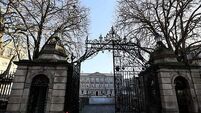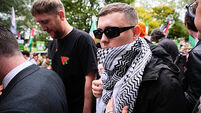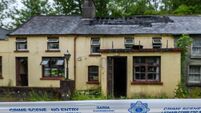Stephen Brandes’ work is part of unsettling programme at RHA

‘April 22nd’ is the last in a series of six pieces, in keeping with Brandes’ recent, large, highly detailed drawings on floor vinyl. Each piece is a diary entry of the fictitious Sitzfleisch, who travels Europe. “He’s sort of a shady character,” says Brandes. “Albert Sitzfleisch is his name, which means ‘sitting flesh’. It’s the nickname Nietzsche gave to Marcel Proust, because he thought he was a lazy bastard. It comes from that idea of imagining the world from one place, interpreting the world that way. So it raises the question — is he travelling or is this his imagination?”
The landscapes through which Sitzfleisch moves, or imagines, are inventions of Brandes’, inspired by the landscape of Eastern Europe. Brandes, who was born in Wolverhampton but lives in Cork, has travelled Eastern Europe, following his grandmother’s route, in 1913, when she was escaping the pogroms in Romania.
Brandes was also inspired by a recent road trip through the old East Germany. “I was struck by how it had changed less than I’d thought it would in 25 years.”
To the foreground of Brandes’ work is a collage of modernist buildings of the kind that dominated post-war Germany. The most recognisable element is the Kyffhauser Monument, 81-metres tall and built on the Kyffhauser mountain in 1896, and featuring Frederick I, or Barbarossa, the 12th-century Holy Roman Emperor. Above him stands Kaiser Wilhelm, who commissioned it. Brandes’ juxtaposition of the monument against 20th-century architecture is ironic. “It is a monument to any kind of nationalistic hubris,” says Brandes.
Brandes’ work is an impressive feat of craftsmanship, drawn ‘live’, in permanent marker pen, on floor vinyl. “The vinyl is surprisingly forgiving, but the marker does have to be permanent,” says Brandes. “I did have a very embarrassing situation with the second piece I’d ever made. It was in red marker, but it wasn’t permanent. The Museum of Modern Art bought it and, a few months later, they opened it up and found it had disappeared. I eventually got it back and redrew the whole thing.”
‘April 22nd’ is complemented by smaller collages on a similar theme, juxtaposing landscapes and monumental architecture, with a nod to the collage tradition of Germany and Russia, in particular Alexander Rodchenko, El Lissitsky and Kurt Schwitters.
The RHA’s autumn programme is defined by a startling use of its galleries, in particular the large, airy spacethat houses Marlene McCarty’s floor-to-ceiling, pencil-and-ink drawings. McCarty’s work is unsettling — her best-known pieces are portraits of teenage girls who murdered their mothers. Here, she uses the same materials and style, making painstaking, detailed drawings that suggest family scenes, but are disturbing Freudian investigations. She also pairs apes and humans, joining us in family portraits of a different kind. This challenges human notions of our privileged status among animals.
The visitor won’t find much to soothe the soul in galleries two and three. Here, the work of Natasja Kensmil, a Dutch painter of Surinamese extraction, cuts to the bone of our mortality, and our illusions of posterity. Kensmil re-imagines portrayals of European monarchs. A portrait of Queen Elizabeth I is removed of pomp and splendour, and drenched in death and decay: the Queen’s dark, skull-like face is surrounded by animal heads, which suggests not power by divine right but by brute strength.
Kensmil then turns to a more contemporary veneration: childhood. Her gaunt figures in swaddling clothes challenge our blithe self-assurances around children; our culture’s constant fretting over them is in the absence of threats all too real in less-privileged parts of the world.
Bennie Reilly’s work is in contrast to these darker topics — yet it is a challenge to the comforting schemas we project onto the world. Reilly’s series, ‘Rara Avis’, is inspired by bird watching. Yet it does not catalogue its subjects. Her paintings are at times transformative, merging the birds in a way that is unfamiliar to the human gaze, making them strange and beautiful, even though some are among the most common of birds.
There is more playfulness in the three-dimensional contributions from Tony O’Malley and Joanna Kidney.
On the centenary of O’Malley’s birth, the RHA is presenting a series of his ‘Constructions’, sculptures in the assemblage tradition of Picasso and Kurt Schwitters. Kidney’s work is a playful use of the RHA’s atrium. Using binoculars, visitors are invited to inspect small objects arranged high up on the wall. What is to the naked eye a colourful scattering becomes, when magnified, something altogether different.
www.rhagallery.ie










